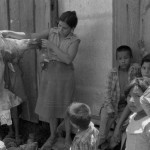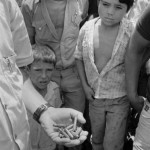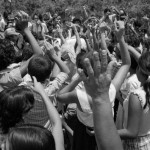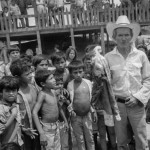What Are Social Media Good For?
Well, at least for the following:
Some time back I received a message through my Twitter account:
“@vinkjohn I’m not sure how much you recall of the Evelio Bonilla Ayala incident as it was 24 years ago, but do you have more pictures”
And later on:
“@vinkjohn of that incident that are not published on your site? I ask only because he’s my father.”
By email I asked Marina Dubon, the person who was sending me the tweets, to wait some time, until I got access to my negatives in Brussels and the exchange went on as follows:
“Hi John,
First of all, I’d like to thank you for taking the time and sending me those pictures. It is surreal to be able to look at photographs of what happened to my father after only hearing about it and seeing the scars on his body.
I’m unsure of the details of my father’s life prior to the civil war, he’s not present in my life but I’ll ask my mom about it and email you again. I can tell you that my parents lived in the refugee camp for about 10 years…that is where they met each other. Three of my siblings and myself were all born there during that time. When this incident happened to my father my mom was actually pregnant with me at the time. That day he was in the corn fields fertilizing the stalks when Honduran soldiers approached him asking him to go outside of the camp limits. My father knew they had bad intentions and told them to give him a moment to put something away and started to flee from them. It was at that moment they began to shoot him. It is by the grace of God my father survived this horrible experience. Because of what happened to my father our family was given the opportunity to come to Canada. My parents did not jump at the opportunity as they didn’t want to leave their families, especially my mom did not want to leave my grandma’s side. The last chance she had to go to an interview to begin the process someone convinced my mom to go and in March of 1990 my father, and 4 of my siblings and myself arrived in Canada. My mother arrived about a month later because she gave birth to my younger brother in March, and about a month or so after that my grandma also arrived in Canada.
I’ve always been curious to know where I came from, how my family lived during those years, etc. The place where this refugee camp used to be is just an empty field with no real signs that it used to be “home” for so many Salvadorians. So every once in awhile I go to Google and search “Mesa Grande Honduras”. And I’ve always had the hope of one day finding pictures of my family, as pictures of them prior to Honduras are non existent. One night I was scrolling through the search results and I saw the one picture of my father. I was viewing it on a mobile device so I clicked on the picture but it was still too small to tell, but seeing him on the stretcher I was almost certain. So I clicked on the link that led me to your site. When I saw the caption on the picture I was confused for a bit because I had never heard the name Evelio (the last names confused me as well but they are a family name), but I knew it was my father. You see during the war Salvadorians, at least those on the FMLN side used pseudonyms to help protect their identity…I later found out Evelio was the name my father used after I asked my mom about it. Anyways, I went through your whole album, I also showed my whole family the pictures. We (and by we I mean mostly my mom and grandma) were able to see familiar faces and a few family members. I wish I could see all your photographs from the camp, it would be such an experience to hear the stories they would stir up in my mom and grandma. But I am truly grateful for the photographs you have provided me as they have helped me further understand this difficult period of my family’s life. You are free to post something on your weblog about this. If you have any other questions let me know.
Kind regards,
Marina”
“Hi Marina,
Fascinating destiny, and so nice to know that it turned out that way… It is so extremely rare to know about what happened to people I photographed. How many times have I thought while looking at the photographs I took years ago: ‘What has become of them?’ In fact I’ve gotten feedback only two or three times with the thousands of people I took photographs of.
Thank you so much for the feedback. It means a lot to me.
I will send you the photographs of Mesa Grande I have scanned and which are not on my website some time later.
I wish you and your family all the very best.
John”
“Hi John,
So here is a little bit more information on my father:
My father is from Chalatenango, Arcatao which is located in northern El Salvador, about 30 km from the Honduran border. He comes from a lower class family, he only went to school up to the third grade. He came to Honduras with his family fleeing the war in 1981, he was about 20 years old when he arrived in Honduras…so he would have been 27 when he was shot. Prior to the war he worked in the fields as a farmer just as many others growing beans and corn to sustain their families. My mom says she doesn’t know too much about my father’s life prior to war so I think this is all the information I can give you.
I’m glad we have been able to connect and have this exchange of photographs and stories. Really, it is a fascinating destiny, especially as children of parents who went through all of this we can see the opportunities we have had that our parents never even dreamed of.
I look forward to the photographs of Honduras! Thank you for everything.
Marina”
Photography can be so powerfull when it comes to stirring up memories…
The story on the refugee camps in Honduras on my website (see here) was updated with new scans and a broader edit.





